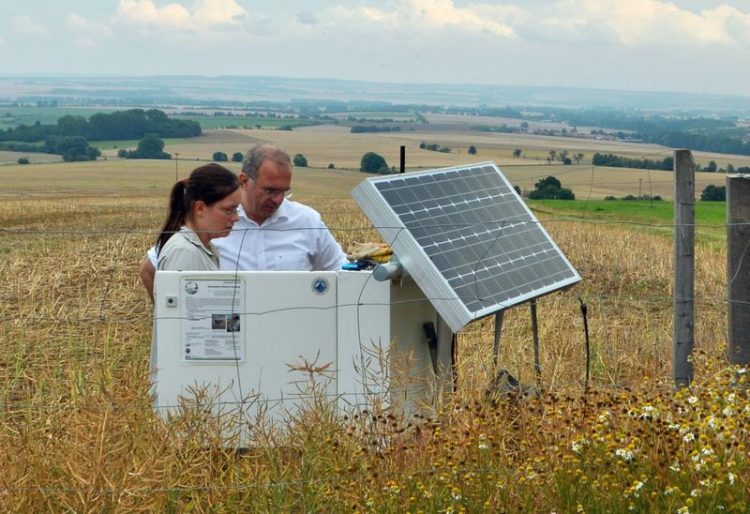Research on clean drinking water

At one of the study areas for soil leachate at the Hainich CZE, Prof. Kai Uwe Totsche and geologist Katharina Lehmann of the University of Jena check the station parameters. Photo: Robert Lehmann
In this country, we take clean drinking water for granted. At least 4.5 billion cubic metres are used in Germany each year – equivalent to some 120 litres per person per day. More than two-thirds of this total comes from groundwater.
But how secure are these essential subsurface water reservoirs in view of intensive land use, environmental pollution and climate change? Researchers at Friedrich Schiller University in Jena, together with partners, are looking into this issue in the Collaborative Research Centre (CRC) ‘AquaDiva’. Started in 2013, the research partnership will continue to be supported by the German Research Foundation (DFG) for the next four years, receiving over 9.5 million euros for the funding period to 2021.
“We are pleased with the recognition of our work to date and this positive evaluation by the DFG will spur us on in tackling our next research tasks,” says Prof. Kirsten Küsel. The Director of the Institute of Ecology of the University of Jena is one of three speakers of the CRC. The aim of the research partnership is to analyse the connections between ground and subsurface habitats of plants and microorganisms, and the processes that take place in those habitats.
The findings will be used to develop recommendations for the sustainable protection of these ecosystems and of the services they provide to people. As well as scientists from the University of Jena, the CRC AquaDiva also includes researchers from the Max Planck Institute for Biogeochemistry (MPI-BGC), the Leibniz Institute of Photonic Technology (IPHT) and the Helmholtz Centre for Environmental Research (UFZ).
‘AquaDiva’ stands for both water (‘Aqua’) and diversity (‘Diva’). Researchers are focusing in particular on what is called the ‘critical zone’, which extends from the near-surface atmosphere down to the bottom of groundwater aquifers. “This habitat has still hardly been investigated,” explains Prof. Susan Trumbore, Managing Director of the MPI-BGC and also a CRC speaker. However, it is precisely the interaction between this life below the surface and the physical and geochemical conditions underground that has a decisive influence on the quality of the groundwater.
During the first funding period, an experimental research platform – the Hainich Critical Zone Exploratory (CZE) – was established near the Hainich National Park in the state of Thuringia. “With this research area of about 25 square kilometres, which, in a way that is unique in the world, is equipped with a multitude of different, innovative measuring and sampling devices, we have a unique opportunity to take water and material samples from the underground compartments, the soils and the groundwater, and to characterise them,” explains Prof. Kai Uwe Totsche.
The hydrogeologist at the University of Jena is a member of the Thuringian Climate Council and he completes the AquaDiva speaker team. In the Hainich National Park, water samples are taken from various depths and at various times, and analysed with the help of high-throughput methods such as high-resolution mass spectrometry and DNA sequencing. In this way, the researchers obtain chemical and biotic ‘fingerprints’ of the individual measuring stations in the CZE.
“The first comprehensive data sets show that the parameters investigated differ significantly from measuring point to measuring point, over the course of the year and after extreme weather events,” says Prof. Küsel. “The data particularly indicate that altered precipitation conditions resulting from climate change lead to changes in the groundwater system,” notes Prof. Totsche. The second phase of the project that is now starting is concerned with identifying the underlying mechanisms that lead to the differences between sites. At the same time, the partnership wants to open up the new research platform to additional partners and international cooperation agreements.
The CRC 1076 ‘AquaDiva’ has more than 55 researchers working on 15 sub-projects. Together with the CRC/Transregio ‘FungiNet’, which has also been extended, and the ongoing CRC ‘ChemBioSys’, ‘AquaDiva’ forms a significant part of the University of Jena’s cluster application ‘Balance of the Microverse’ in the excellence strategy of the federal and state governments. The association is also supported by the Free State of Thuringia. You can find further information under: http://www.aquadiva.uni-jena.de.
Contact:
Prof. Kirsten Küsel
Institute of Ecology of Friedrich Schiller University, Jena
Dornburger Str. 159, D-07743 Jena, Germany
Phone.: +49 (0)3641 / 949461
E-mail: Kirsten.Kuesel[at]uni-jena.de
Media Contact
All latest news from the category: Life Sciences and Chemistry
Articles and reports from the Life Sciences and chemistry area deal with applied and basic research into modern biology, chemistry and human medicine.
Valuable information can be found on a range of life sciences fields including bacteriology, biochemistry, bionics, bioinformatics, biophysics, biotechnology, genetics, geobotany, human biology, marine biology, microbiology, molecular biology, cellular biology, zoology, bioinorganic chemistry, microchemistry and environmental chemistry.
Newest articles

Silicon Carbide Innovation Alliance to drive industrial-scale semiconductor work
Known for its ability to withstand extreme environments and high voltages, silicon carbide (SiC) is a semiconducting material made up of silicon and carbon atoms arranged into crystals that is…

New SPECT/CT technique shows impressive biomarker identification
…offers increased access for prostate cancer patients. A novel SPECT/CT acquisition method can accurately detect radiopharmaceutical biodistribution in a convenient manner for prostate cancer patients, opening the door for more…

How 3D printers can give robots a soft touch
Soft skin coverings and touch sensors have emerged as a promising feature for robots that are both safer and more intuitive for human interaction, but they are expensive and difficult…





















